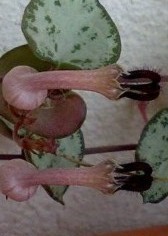Chain of Hearts
(Ceropegia collaricorona collaricorona)

Description
Ceropegia woodii is a flowering plant in the dogbane family Apocynaceae, native to South Africa, Eswatini and Zimbabwe. It is sometimes treated as a subspecies of the related Ceropegia linearis, as C. linearis subsp. woodii. Common names include chain of hearts, collar of hearts, string of hearts, rosary vine, hearts-on-a-string, and sweetheart vine. In 1881, the species was discovered hanging from rocks on Groenberg Mountain in Natal, SA, at an altitude of 1800 feet, by John Medley Wood, curator of the Durban Botanic Gardens. Thirteen years later, in 1894, he sent a living plant to the Royal Botanic Gardens, Kew, UK. The plant that had been sent to Kew subsequently flowered, providing the material for Plate 7704 of Curtis's Botanical Magazine published in 1900. The prolific botanical artist Matilda Smith prepared the plate, while the Kew taxonomist, N. E. Brown, produced a detailed description, naming the plant after its discoverer. Its trailing habit, neat appearance, and tolerance of neglect, made it an ideal plant for hanging baskets. Its leaves are shaped like hearts, about 1–2 cm wide and long. When exposed to sufficient light they have a deep green colour; under insufficient lighting the leaves are pale green. With age it develops a woody caudex at its base. The roots, and occasionally the stems, will often develop tubers. On the stems these tubers form at nodes and are likely the reason for the common name of rosary vine. In general, the flower form is similar to those of other Ceropegia species. The corolla grows to 3 cm in length and is a mixed colouring of off-white and pale magenta. The five petals are a deeper purple. Ceropegia woodii is tender and in temperate regions it is a very popular houseplant, often grown in hanging baskets so the long trailing branches may hang down with their leaves spaced out like a row of large beads. Several cultivars have been selected, some with variegated leaves. It requires excellent drainage, should be watered only when dry, and should never stand in water. Excess water should be removed from plant saucer after watering. It can be grown outdoors only in subtropical and tropical areas having a minimum temperature of 15°C (59°F). Partial shading is useful when the plant is grown outdoors. So if you plan to grow yours outdoors, make sure to put it in a spot where this plant can get at least 3 to 4 hours of bright, indirect sunlight and some shade in the afternoon.
Taxonomic tree:







